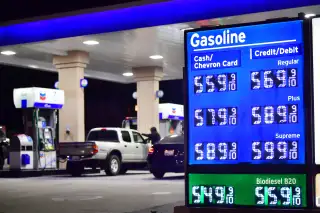Gas Prices Are Set to Hit a Record High After Rising 45 Cents in a Week

Gas prices jumped 45 cents last week, bringing the national average over $4 a gallon for the first time since 2008. Experts anticipate that U.S. gas prices will blow past the all-time record high of $4.11 early this week.
[UPDATE: As of Tuesday, the average price for a gallon of gas was $4.17, according to AAA. That's the highest it's ever been.]
The last time gas prices were averaging over $4 a gallon in America, it was the summer of 2008 and wholesale crude oil prices had spiked to over $140 a barrel. Fast-forward to 2022, and global oil prices have soared since Russia, a major oil producer, invaded Ukraine in late February. Crude oil prices hit $130 a barrel recently; some analysts are forecasting prices could rise to $150.
Because consumer gas prices are derived mostly from the cost of wholesale oil, drivers are feeling serious pain at the pump.
As of Monday, gas prices were averaging roughly $4.06 per gallon nationally, according to AAA. That's an increase of 45 cents in one week and is $1.30 more than gas cost one year ago. Gas now costs more than $4 in 17 states and Washington, D.C., on average, and prices are well over $5 a gallon in many cities.
Drivers are shocked not simply because prices are high, but also because gas has gotten so expensive so quickly. After all, in the pandemic-affected economy of spring and early summer 2020, gas prices were under $2 a gallon in most of the country.
In other words, gas prices have doubled in less than two years.
U.S. gas prices rose to a multi-year high last fall due to a range of factors, including supply chain problems, widespread inflation, increasing energy demands and diminished output of oil producers around the world.
Government officials claimed that gas prices would drop in early 2022, yet those predictions never crystallized. Instead, amid heightened tensions along the Russia-Ukraine border, oil and gas prices crept higher week after week — and then skyrocketed after the Russian invasion began Feb. 24.
A gallon of regular gasoline in the U.S. was selling for an average of $3.53 just before Russia invaded. Since then, prices shot up 54 cents to $4.07 a gallon, an increase of about 15% in less than two weeks.
“There are few words to describe the unprecedented rise in gasoline prices," Patrick De Haan, head of petroleum analysis at the gas price-tracking app GasBuddy, said in a blog post on Monday. "Forget the $4 per gallon mark, the nation will soon set new all-time record highs and we could push closer to a national average of $4.50. California could be heading for $5.50 per gallon with more stations charging $6 and beyond.”
What with continued soaring prices and uncertainty in global oil markets, no one can say when drivers can expect any relief at the pump. The U.S. and European allies are currently exploring the possibility of a full ban of Russian oil imports. If that happens, it's expected global oil prices will rise further, followed by even higher prices at gas stations.
If there's any consolation, it's the fact that the record-high gas prices of 2008 represented a lot more money back then. Paying $4.11 per gallon in July 2008 is the equivalent of $5.25 in 2022, after adjusting for inflation.
In other words, if we factor in inflation — and we should, because true buying power matters more than basic dollar amounts — U.S. gas prices won't break the record high until they cost more than $5.25 a gallon, on average.
The War in Ukraine Is Shaking Markets — and Undermining a Key Argument in Favor of Bitcoin
Best Car Insurance Companies of 2022
Ukrainian Vodka Sales Soar as Drinkers Boycott Russian Brands